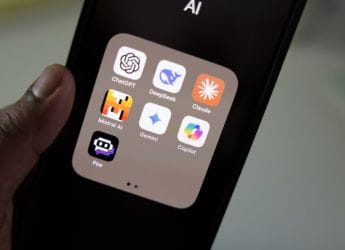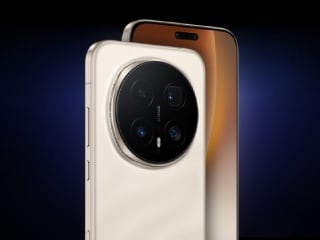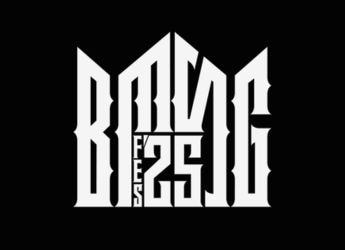- Home
- Mobiles
- Mobiles Reviews
- Nokia 3.2 Review
Nokia 3.2 Review
Are stock Android and a beefy battery enough to sway buyers towards the Nokia 3.2?

The Nokia 3.2 is large and chunky, which means one-handed usage is a bit of a struggle
HMD Global has been vying to capture a share of the budget smartphone segment in India ever since it revived the Nokia brand, but the relatively high prices of its phones and the presence of competitors that offer more bang for the buck have kept Nokia from recapturing its former glory. The Nokia 3.2 is the company's latest attempt at offering an affordable phone that looks to strike the right balance between features, experience, and price. The phone packs a large display with a modern waterdrop notch design and a large 4000mAh battery. On top of that, the Nokia 3.2 offers a stock Android experience with the promise of timely updates.
However, HMD has also made some serious compromises to keep the price in check. The quad-core SoC at the heart of Nokia 3.2 looks underpowered on paper, and the imaging hardware too seems less impressive than what we're now used to seeing at this price level. Has the company cut costs in the right places, or is the Nokia 3.2 just another budget phone that is destined to lay down arms in the face of intense competition? Let's dive right into our review and find out.
Nokia 3.2 design
The design of the Nokia 3.2 can be described as utilitarian at best, but some will find the understated look appealing. The phone has a polycarbonate unibody with curved sides that extend all the way to the 2.5D curved glass on the front. The rear panel looks like glass and has a reflective finish.
However, it attracts dust particles and smudges rather quickly, and we found this to be more easily visible on the Nokia 3.2's black variant, which we have for review. The Nokia 3.2 comes in a steel grey colour option as well.
HMD Global has eschewed the premium glass bodies of its pricier offerings in favour of polycarbonate to keep the price of the Nokia 3.2 in check, but it has another disadvantage. The phone's glossy rear panel gets scratched easily, and we noticed a lot of scuff marks within just a week of using the phone. If you want to prevent this, you'll have to buy a protective case as the retail package does not include one.
![]() The Nokia 3.2 has a unibody polycarbonate build, but the rear panel gets scuffed easily
The Nokia 3.2 has a unibody polycarbonate build, but the rear panel gets scuffed easily
When it comes to in-hand feel, the Nokia 3.2 is not the most comfortable phone to use. The phone has a large profile, which means one-handed usage is out of the question here. We often had to adjust the phone in our hands and stretch our thumb to reach content at the far corners of the screen. On a similar note, the volume rocker is also a little difficult to reach due to its placement.
The right side has the volume rocker and the power button, which also doubles as a notification light. Unlike the power button on the Nokia 4.2 (Review), which is surrounded by a ring of light, the power button here has a thin white strip in the middle that lights up when a notification arrives. Although it is not as bright as the one on the Nokia 4.2, the power button indicator on the Nokia 3.2 gets the job done just fine.
There is a dedicated Google Assistant button on the left, a feature that is hard to find on a phone in the sub-Rs. 10,000 price segment. A single press brings up the Google Assistant, while double-pressing the button opens a page populated with contextual information and suggestions based on your activity and location. You can choose to disable the Google Assistant button, but you can't remap it to perform any other task.
The rear camera module is ever so slightly raised, while the fingerprint sensor sits below it. The bottom of this phone has a Micro-USB port and speaker, while the 3.5mm headphone jack can be found at the top. On the left, you will also find the SIM tray, which can house two Nano-SIMs and simultaneously a microSD card of up to 400GB capacity.
Nokia 3.2 specifications and features
The Nokia 3.2 packs a 6.26-inch HD+ (720x1520 pixels) display with a 19:9 aspect ratio and a waterdrop notch at the top. This new phone is powered by the quad-core Qualcomm Snapdragon 429 processor, which is a little disappointing considering the fact that there are more powerful and lower priced phones such as the Redmi Note 7 (Review) with the octa-core Snapdragon 660, and the Realme 3 (Review) with the MediaTek Helio P70 processor.
![]() The display does not render punchy colours, but the sunlight legibility is decent
The display does not render punchy colours, but the sunlight legibility is decent
The Nokia 3.2 comes in two variants — the base variant with 2GB of RAM and 16GB of storage priced at Rs. 8,990, and a higher-end variant with 3GB of RAM and 32GB of storage priced at Rs. 10,790, which is the one we have for review.
For connectivity, there's 4G VoLTE, Wi-Fi 802.11 b/g/n, Bluetooth 4.2, GPS/ A-GPS, FM radio, a 3.5mm audio jack, and a Micro-USB port with OTG support. Authentication is handled by face recognition and a rear-mounted fingerprint sensor. Surprisingly, the 2GB RAM variant of the Nokia 3.2 misses lacks a fingerprint sensor. This omission on a phone that costs as much in 2019 is quite disappointing, and cannot be excused.
The phone also has an ambient light sensor, proximity sensor, and accelerometer. There is Qualcomm aptX audio codec support, which means users can listen to high-quality music over wireless headphones.
The imaging hardware on the Nokia 3.2 is also a letdown. This phone packs a single 13-megapixel rear camera with an f/2.2 aperture and 1.12 micron pixels. It is disappointing to see this phone miss out on a secondary depth sensor, when nearly all phones in this segment offer dual rear cameras. Selfies are handled by a fixed-focus 5-megapixel camera with an f/2.2 aperture and 77-degree field of view.
The Nokia 3.2 also lacks camera features such as a portrait mode, AR stickers, scene modes, and a pro mode for manual control, to name a few. The camera app is quite basic with little to explore in terms of photography tools, but thankfully, there is Google Lens integration and it worked fine.
On the software side, the Nokia 3.2 is a part of the Android One programme and runs Android 9 Pie. Our review unit initially ran the dated February security patch, but the phone has now been updated with the May 2019 Android security patch.
When it comes to software, the Nokia 3.2 outclasses many of its rivals with the promise of assured OS updates for at least two years. The phone will continue to receive security updates for up to three years, which not many phones in this price bracket can claim to offer.
As for the user experience, well, stock Android certainly has a lot of fans for its relatively clean design and no-frills, no-fuss approach. Another advantage is that the Nokia 3.2 won't annoy users with lots of bloatware and pesky ads, something Android skins such as MIUI are criticised for.
![]() The phone packs a single rear camera, and its performance falls short of the competition
The phone packs a single rear camera, and its performance falls short of the competition
The Nokia 3.2 offers the usual set of Android tools including Adaptive Battery, Digital Wellbeing, Ambient Display, and Adaptive Brightness. Stock Android means users miss out on a tonne of features available on custom skins like the ability to run two instances of popular apps like WhatsApp, a bike mode, and a dedicated gaming mode.
Nokia 3.2 performance, cameras, and battery life
The Nokia 3.2 offers a large 6.26-inch HD+ (720x1520 pixels) display with a density of 269ppi. Even though Nokia is marketing the large display of the phone as a multimedia-friendly feature, this is not the most high resolution display out there and colour reproduction wasn't all that good either. Also, the phone does not come with Widevine L1 certification, which means you can't stream HD content from services such as Netflix.
The lack of sharpness was instantly noticeable, especially with CGI animated visuals. Colours didn't look punchy on this screen, and even though the brightness was decent, the reflective panel was slightly annoying. Barring that though, we did not have any other issues with viewing content under sunlight. The viewing angles are decent, but if you are looking at videos with dark scenes, you might lose some of the textures and colour shifts.
Coming to the performance of this phone, the Nokia 3.2 is easily outgunned by rivals. The Snapdragon 429 powering it is barely enough for heavy multitasking, and is significantly slower and less capable than the Snapdragon 660 and MediaTek P70 Soc in phones priced lower than the Nokia 3.2's top-end variant with 3GB of RAM that currently goes for Rs. 10,290. One can buy the Redmi Note 7 and Realme 3 for a lower asking price, and get significantly higher value for money in the process.
Despite running stock Android and avoiding a resource-hogging custom Android skin, the Nokia 3.2 feels a little slow from the get-go. Switching between apps and loading them felt sluggish. Even when using Google's own apps like Maps and Chrome, the phone did not feel zippy at all. Thankfully, apps did not crash, and day-to-day usage was stable, but the phone occasionally froze and the UI became unresponsive under stress.
![]() The Nokia 3.2 ships with Android Pie, but the UI experience is sluggish
The Nokia 3.2 ships with Android Pie, but the UI experience is sluggish
Regular productivity and social media apps ran without a hitch, but the performance limitations of the quad-core SoC became noticeable while playing games such as PUBG Mobile and Asphalt 9. They both ran at their lowest settings, and there were still too many stutters and instances of delayed or unresponsive touch inputs, which made both games unenjoyable. Also, having a game in the background took a heavy toll on the fluidity of app switching.
Looking over to the competition, the Xiaomi Redmi 7 ran PUBG Mobile at Medium settings, and delivered a smoother experience.
As far as synthetic benchmarks go, the Nokia 3.2 scored 849 and 2,444 in Geekbench 4's single and multi-core tests. In AnTuTu, the Nokia 3.2 put up a weak score of 64,346. The graphics-intensive 3DMark Slingshot Extreme returned a score of 190.
To sum up, Nokia 3.2 is not suited for heavy multitasking or gaming. We came to this conclusion after testing the higher-end variant of the phone with 3GB of RAM, so you can expect even worse from the base variant packing 2GB of RAM.
The fingerprint sensor on our review unit worked well, but we cannot say the same for face recognition, which struggled even in well-lit conditions. Navigation gestures are supported, but their implementation is not particularly smooth on the Nokia 3.2 and we often found the UI lagging while multi-tasking.
As far as camera experience goes, the Nokia 3.2 offers entry-level imaging hardware with just the basic camera controls and no software tricks like a bokeh mode, AR stickers, portrait light effects, etc. The camera UI offers just three basic modes at the bottom — photo, video, and square.
The ‘more' button will let you choose between panorama, time-lapse, and Google Lens. There is also a beauty mode, that lets you adjust the strength of beautification by moving a slider, but there are no fine-grained controls. At the top, you can find the HDR, timer and flash buttons.
The camera performance of Nokia 3.2 is just decent for the price, but it falls short of the results delivered by the lower-priced Realme 3 (Review) and Redmi 7 (Review). The photos taken by the 13-megapixel rear camera retain natural colours and decent sharpness, and look good on the phone's screen. The Nokia 3.2 did not struggle with locking focus, a problem which plagued the Nokia 4.2, and we also didn't have to deal with the same slow shutter issue.
Photos shot under natural light had good colours, but they look a little muted. Checking them out on a larger screen showed some softening and grainy texture, particularly with long-range shots, but they were generally good enough to share on social media platforms. The phone failed miserably at handling harsh sunlight, showing washed-out colours and streaks of light seeping in from the edges. We noticed that the dynamic range in photos taken by the Nokia 3.2 was at par with those captured by the pricier Nokia 4.2 (Review).
Indoor photos taken in well-lit conditions looked decent, but they weren't particularly sharp. The exposure slider is a little too aggressive at brightening or dimming a frame, which sometimes made it difficult to capture a photo in which the subject did not appear unnecessarily dark or bright. Photos captured in low light had a lot of noise and grainy texture.
We were pleased with macros taken in HDR mode, as the photos turned out vibrant. As mentioned above, there is no dedicated bokeh mode, but focusing on an object for macro shots blurs the background to deliver the depth of field effect. The lack of a dedicated depth sensor is quite apparent here, as the Nokia 3.2 often struggled to detect the edges of the object in focus, and there is also no way to adjust the blur intensity.
![]()
![]()
![]()
![]()
![]() Tap to see full-sized Nokia 3.2 camera samples
Tap to see full-sized Nokia 3.2 camera samples
Selfies captured by the 5-megapixel front camera on the Nokia 3.2 can be classified as average at best. The front camera tended to brighten photos by default and did a fair bit of skin smoothening without even using the beautification filter. As a result, colours looked washed-out in selfies taken in the daylight, and there was not much in terms of finer details like skin textures. There was not much detail in the background either. Low-light selfies turned out to be sub-par, with a lot of grainy texture, minimal sharpness, and an overall dark appearance.
As far as videos go, the front and rear cameras on the Nokia 3.2 can both record at full-HD and HD resolutions. Videos shot by the rear camera had decent clarity and colours, but they are plagued with jerkiness due to lack of any stabilisation technology.
The battery of the Nokia 3.2 is its key highlight. With regular usage that involved Internet surfing, social media usage, occasional calls, around two hours of music playback, and a little bit of casual gaming, the phone easily went beyond a day of usage. We found that the Nokia 3.2 still had around 30 percent of its power left in the battery at the end of the day.
In our HD video loop test, the phone lasted for 10 hours and 31 minutes, which is quite low for a phone packing a 4,000mAh battery. There's no quick charging, and the bundled charger takes over two and a half hours to take the battery from 0 to 100 percent.
Verdict
The Nokia 3.2 is targeted at folks looking for a phone with a large display suitable for multimedia consumption, and also one that packs a large battery that easily lasts over a day. And even though the display quality could have been better, the Nokia 3.2 delivers on those two counts. The bloatware-free Android experience and timely updates are also bonuses, but that is just about all there is on the positive side.
The Nokia 3.2, starting at Rs. 8,990 for the base variant with 2GB of RAM, has an underpowered processor that makes the phone feel sluggish. It struggled at multitasking and gaming in our tests. The camera output barely rises above the average, and the build quality and design are not all that great either.
The biggest concern we have with this phone is its price. Starting at 8,990, the Nokia 3.2 feels overpriced. Plus, the base variant misses out on a fingerprint sensor and will definitely offer worse performance than the 3GB RAM variant we have reviewed. The Realme 3 (Review) and Redmi 7 (Review) offer much better performance, cameras, and overall value compared to the base variant of the Nokia 3.2.
The higher-end version with 3GB of RAM, carrying a price tag of Rs. 10,790, is no match for the value the competition offers. The freshly launched Redmi Note 7S (Review), priced a tad higher, offers a 48-megapixel camera, faster processor, better design, and overall better value for money. One could also consider the Redmi Note 7 Pro (Review), Realme 3 Pro (Review), or Asus ZenFone Max Pro M2 (Review) at slightly higher prices.
Get your daily dose of tech news, reviews, and insights, in under 80 characters on Gadgets 360 Turbo. Connect with fellow tech lovers on our Forum. Follow us on X, Facebook, WhatsApp, Threads and Google News for instant updates. Catch all the action on our YouTube channel.
Related Stories
- Samsung Galaxy Unpacked 2025
- ChatGPT
- Redmi Note 14 Pro+
- iPhone 16
- Apple Vision Pro
- Oneplus 12
- OnePlus Nord CE 3 Lite 5G
- iPhone 13
- Xiaomi 14 Pro
- Oppo Find N3
- Tecno Spark Go (2023)
- Realme V30
- Best Phones Under 25000
- Samsung Galaxy S24 Series
- Cryptocurrency
- iQoo 12
- Samsung Galaxy S24 Ultra
- Giottus
- Samsung Galaxy Z Flip 5
- Apple 'Scary Fast'
- Housefull 5
- GoPro Hero 12 Black Review
- Invincible Season 2
- JioGlass
- HD Ready TV
- Laptop Under 50000
- Smartwatch Under 10000
- Latest Mobile Phones
- Compare Phones
- Honor Win RT
- Honor Win
- Xiaomi 17 Ultra Leica Edition
- Xiaomi 17 Ultra
- Huawei Nova 15
- Huawei Nova 15 Pro
- Huawei Nova 15 Ultra
- OnePlus 15R
- Asus ProArt P16
- MacBook Pro 14-inch (M5, 2025)
- OPPO Pad Air 5
- Huawei MatePad 11.5 (2026)
- Xiaomi Watch 5
- Huawei Watch 10th Anniversary Edition
- Acerpure Nitro Z Series 100-inch QLED TV
- Samsung 43 Inch LED Ultra HD (4K) Smart TV (UA43UE81AFULXL)
- Asus ROG Ally
- Nintendo Switch Lite
- Haier 1.6 Ton 5 Star Inverter Split AC (HSU19G-MZAID5BN-INV)
- Haier 1.6 Ton 5 Star Inverter Split AC (HSU19G-MZAIM5BN-INV)


















